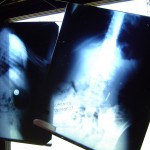Many patients do not ask questions about the types of diagnostic medical imaging tests their doctors order. However, patients should not be afraid to start a dialog with their doctors and talk about whether it might make sense to have a second, different type of scan done at the same time. In many cases, doing so can save the patient time and money.
 Having two scans done during the same visit can work well for a couple of reasons. First, the patient pays for just one office visit. Second, complementary medical imaging tests can provide different and useful information about the area being examined, giving doctors a more complete picture to use when making diagnostic and treatment decisions.
Having two scans done during the same visit can work well for a couple of reasons. First, the patient pays for just one office visit. Second, complementary medical imaging tests can provide different and useful information about the area being examined, giving doctors a more complete picture to use when making diagnostic and treatment decisions.
For example, some doctors will request tomosynthesis (another name for 3D mammography) be done at the same time as a regular mammogram. This is often done for women with dense breast tissue or those at high risk for breast cancer. By combining these scans, doctors receive a more complete picture, which decreases the rate of false-positives. In turn, fewer false positives mean that patients have to undergo fewer diagnostic tests and other procedures that would typically be used to gather more information before ruling out breast cancer. Additionally, the cost for doing these tests together is often less than doing them separately, making it potentially time and cost effective for patients to consider having a combined mammogram/tomosynthesis scan.
The same benefits can be realized by having an X-ray/MRI combined scan. An MRI gives doctors different information about internal structures than an X-ray. For example, it shows the soft tissue – such as ligaments and cartilage – more clearly than an X-ray, which better shows bones and other hard objects. This can help doctors more accurately identify abnormalities and reduce the need for additional testing.
In addition to mammogram/tomosynthesis and X-ray/MRI combinations, other diagnostic medical imaging tests that complement each other well are PET/CT, PET/MRI and X-ray/ultrasound. Patients should always talk to their doctors about the possibilities of combining these tests and understand whether doing so could result in time and cost savings. Additionally, our professionals at the Center for Diagnostic Imaging, Miami, are always available to answer questions about scans and the various costs involved.





